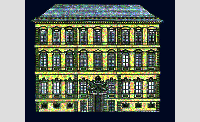The headquarters of biblioiteca, closed in July 2014, represents the origins and evolution of our library collections. The Library occupied part of the second and third floor of the ex College Of Jesus's Society, that today lodges the rectorship and a few faculties of the University of Studies in Genoa, as well as the readapted church of SS. Gerolamo and Francesco Saverio of the same Society.
 The College Palace, designed by Bartholomew Bianco and financed by the Balbi family, extends towards the hill on its back and the steep configuration of the ground has conditioned the development since the beginning. The monumental building proposes, with its two different courtyards placed at two different levels on the slope, a space solution which is different from the usual schemes of the Jesuitic architecture. The palace, concluded only in the first half of '700, appears there like a scenography: from the portal, supported with a centring on ring columns, to the foyer, and finally to the binate column courtyard with open gallery, introduced from a grand staircase at one ramp and dominated by two covered and uncovered "loggia", up to reach at last the superior internal courtyard.
The College Palace, designed by Bartholomew Bianco and financed by the Balbi family, extends towards the hill on its back and the steep configuration of the ground has conditioned the development since the beginning. The monumental building proposes, with its two different courtyards placed at two different levels on the slope, a space solution which is different from the usual schemes of the Jesuitic architecture. The palace, concluded only in the first half of '700, appears there like a scenography: from the portal, supported with a centring on ring columns, to the foyer, and finally to the binate column courtyard with open gallery, introduced from a grand staircase at one ramp and dominated by two covered and uncovered "loggia", up to reach at last the superior internal courtyard.
The College Church was built under the direction of Francesco Bianco and of Father Horace Grasso, has one nave and four side chapels and was finished in 1667. The interior decoration was begun started in 1666. The only today visible to the public zone is the chorus, frescoed by genoese Dominic Piola (1627-1703) and by his pupils and completed by ‘trompe l'oeil’ type architectural paintings by Bolognese Paolo Brozzi. The public, which enters into the reading hall can today enjoy a very neat and close view of some of the chorus frescos, like only the restorers normally have the privilege to see, from the scaffolding in normal work situations. While the "ensemble effect" of the pictorial cycle of the church is very difficult to be captured in modern times, the commemorative purpose and the magnificience of the buyer, Francesco Maria heir of Pantaleo Balbi, and of the religious program of Jesus's Society, is still perceptibe today.